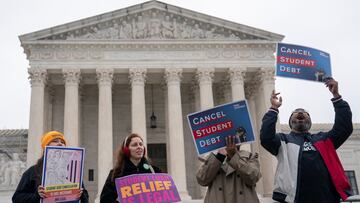What to know while we wait for the Supreme Court decision on student loan forgiveness
All the information we have regarding the anticipated ruling by the Supreme Court on President Biden’s student debt plan.


Millions of student debt holders are anxiously awaiting the decision of the US Supreme Court to uphold or declare unconstitutional President Biden’s executive order to cancel up to $20,000 in student loans. A decision is thought to be very near and could be announced in the next week.
All in all, the Department of Education estimates that there are 44 million people eligible for relief, with 26 million applying for loan cancelation before the courts began to hold up the implementation of the program. Together these borrowers owe around $1.78 trillion, up from around $400 billion in 2006, with the average balance growing $10,000 to $30,600 by 2021.
Those making under $125,000 a year and who received a Pell Grant to fund their higher education can have up to $20,000 canceled, while those who did not receive a Pell Grant are eligible to have half of that amount forgiven. The program under evaluation by the Supreme Court is estimated to cost the federal government $400 billion over the next three decades if deemed constitutional and implemented.
What will the White House do if the program is deemed unconstitutional?
President Biden has remained quiet on what his administration would do if the program is rejected by the Supreme Court. The Department of Education reminded borrowers in November that they should be prepared to begin paying back their student loans this summer, even if the court cancels the program.
It’s good they are sharing this number—but the best suicide prevention strategy is full student debt cancelation. https://t.co/rznRb8qxxD
— The Debt Collective 🟥 (@StrikeDebt) June 28, 2023
The extension of the student loan moratorium is scheduled to lapse 60 days after June 30 or the actual day that the Supreme Court makes a decision on the student debt program, whichever comes first. Federal student loan repayments would resume around August 30, unless the Biden government decides to prolong the moratorium.
A college degree, is it still worth the price tag?
Related stories
The value of obtaining a bachelor’s or advanced degree is seen clearly when it comes to employment and pay. The unemployment rate for those with a bachelor’s, master’s, or Ph.D. is 1.9 percent, while that for those with a high school diploma is 3.9 percent. Regarding income, the Bureau of Labor Statistics reported that in 2021, those who had graduated from college earned an average of at least $1,300, while the average for all workers was $1,057.
However, as student loan balances have risen rapidly over the two decades, the additional income, in terms of purchasing power, a worker can obtain for having completed their degree has diminished.

